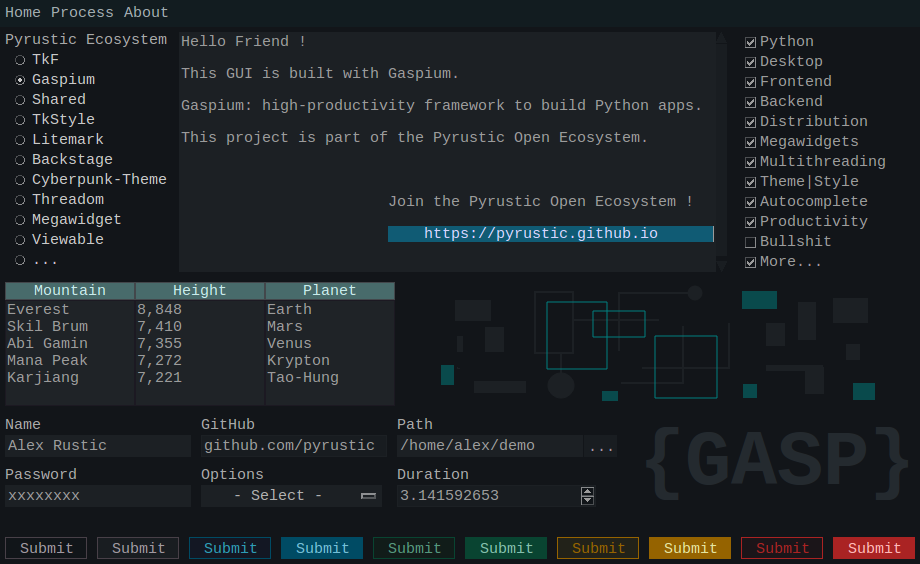Framework to build Python apps with the GASP metaphor
Project description

Gaspium
Framework to build Python apps with the GASP metaphor
This project is part of the Pyrustic Open Ecosystem.
Installation . Demo . Latest . Documentation
Table of contents
Overview
Gaspium is a framework that allows you to create applications with the GASP (GUI As Stapled Pages) metaphor.
In short, we define pages to which we add graphical components. Then we add these pages to an instance of the App class. The first page added is de facto the home page and it will be open when the application is started. Adding a page makes it automatically referenced in the application's navigation bar. You can open an arbitrary page of your application directly from the command line.
Gaspium serves as the reference implementation of the GASP concept.
Discover the GASP concept !
App
It is the main class of the Framework. An instance of the App class represents the running application. It is to this instance that the developer adds Pages.
from gaspium import App
app = App()
# ...
# Here you add pages to the app
# The first page is considered the home page
# ...
# The last line starts the app (mainloop)
# The home page will open automatically
app.start()
The App class accepts arguments like the theme to use, the geometry of the window, whether the caching should be enabled or not, et cetera. The App class also has the add method to add a page to the application, open method to open a page, start method to start the application, exit method to exit the application, et cetera.
Read the App documentation.
Page
A Page is either a function or a Viewable subclass. Each Page added to the App instance is either manually or automatically assigned a unique page identifier, the PID, and automatically referenced in the navigation bar. A page is rebuilt or not at each opening depending on whether the caching feature has been activated or not.
import tkinter as tk
from viewable import Viewable
from gaspium import App
def home_page(context):
"""Home Page. Must accept the dto argument"""
# the dto contains some useful objects
app = context.app
pid = context.pid
data = context.data
root = context.root
# the page function must returns the body
# i.e. the graphical container of the page
body = tk.Frame(root)
label = tk.Label(body, text="Home")
label.pack()
return body
class LoginPage(Viewable):
"""
Login Page
"""
def __init__(self, context):
"""
The constructor must accept the dto argument
"""
super().__init__()
# the dto contains some useful objects
self._app = context.app
self._pid = context.pid
self._data = context.data
self._root = context.root
# the body of the page
self._body = None
def _build(self):
self._body = tk.Frame(self._root)
label = tk.Label(self._body, text="Login")
label.pack()
def on_open_home(context):
"""
This on_open callback must accept a dto object
"""
# redirect to login_page
# instead of letting the home_page open
app = context.app
app.open("login")
app = App(caching=False)
# Add home_page and bind the 'on_open_home' callback
# to perform a custom redirection to login_page
app.add(home_page, title="Home", on_open=on_open_home)
# Add login_page (it won't be referenced in the navigation bar)
app.add(LoginPage, pid="login", title="Login", indexable=False)
# The home page will open automatically
app.start()
Play with the Demo.
Command line aware
By default, when you run a GASP application, the first page added to the App instance opens as the home page. It is possible to open an arbitrary page of the application from the command line. To do this, just put its PID (Page ID) as an argument on the command line. The strings entered after the identifier are considered as data to be sent to the page when it is opened.
$ my-app login "Alex Rustic"
# the login page will open
Batteries included
Gaspium comes with a handful of useful lightweight packages.
| Name | Description |
|---|---|
| Backstage | Extensible command line tool for managing software projects |
| Cyberpunk-Theme | A modern dark theme for Python apps |
| Shared | Data exchange and persistence |
| Subrun | Intuitive API to safely start and communicate with processes in Python |
| TkStyle | Library to create styles and themes for Python apps |
| Megawidget | Collection of megawidgets to build graphical user interfaces for Python apps |
| Viewable | Python library to implement a GUI view with lifecycle |
| Threadom | Tkinter-compatible multithreading |
| Suggestion | Democratizing auto-complete(suggest) for Python desktop applications |
| Kurl | Konnection URL: HTTP requests in Python with an implementation of conditional request and a responses caching system |
Installation
Gaspium is cross platform and versions under 1.0.0 will be considered Beta at best. It is built on Ubuntu with Python 3.8 and should work on Python 3.5 or newer.
For the first time
$ pip install gaspium
Upgrade
$ pip install gaspium --upgrade --upgrade-strategy eager
Demo
A demo is available to play with as a Github Gist. Feel free to give a feedback in the comments section.
Play with the Demo.
Project details
Download files
Download the file for your platform. If you're not sure which to choose, learn more about installing packages.
Source Distribution
Built Distribution
File details
Details for the file gaspium-0.0.5.tar.gz.
File metadata
- Download URL: gaspium-0.0.5.tar.gz
- Upload date:
- Size: 14.8 kB
- Tags: Source
- Uploaded using Trusted Publishing? No
- Uploaded via: twine/1.15.0 pkginfo/1.6.1 requests/2.9.1 setuptools/50.3.2 requests-toolbelt/0.9.1 tqdm/4.54.0 CPython/3.5.2
File hashes
| Algorithm | Hash digest | |
|---|---|---|
| SHA256 | 4b9e171e997c3af63d5cb552bb61504e2516d9ef02be1e985b22d9a3c21bdd64 |
|
| MD5 | ec76339ee14ffab04ce0b00a785f2cfb |
|
| BLAKE2b-256 | a842d8ca164c655791650ba83784faecdda328822892cb282c58a262267a273b |
File details
Details for the file gaspium-0.0.5-py3-none-any.whl.
File metadata
- Download URL: gaspium-0.0.5-py3-none-any.whl
- Upload date:
- Size: 32.0 kB
- Tags: Python 3
- Uploaded using Trusted Publishing? No
- Uploaded via: twine/1.15.0 pkginfo/1.6.1 requests/2.9.1 setuptools/50.3.2 requests-toolbelt/0.9.1 tqdm/4.54.0 CPython/3.5.2
File hashes
| Algorithm | Hash digest | |
|---|---|---|
| SHA256 | 0370819f48ab290039a499233b02869ca21651c8df5528dc1d216ac6172ed3ae |
|
| MD5 | 280ff56b1c17ae5342ffdde375b3a0cc |
|
| BLAKE2b-256 | 9d678607347b2d1904c96d31063534f8574ee0661ceac7c830acb914393e6953 |











